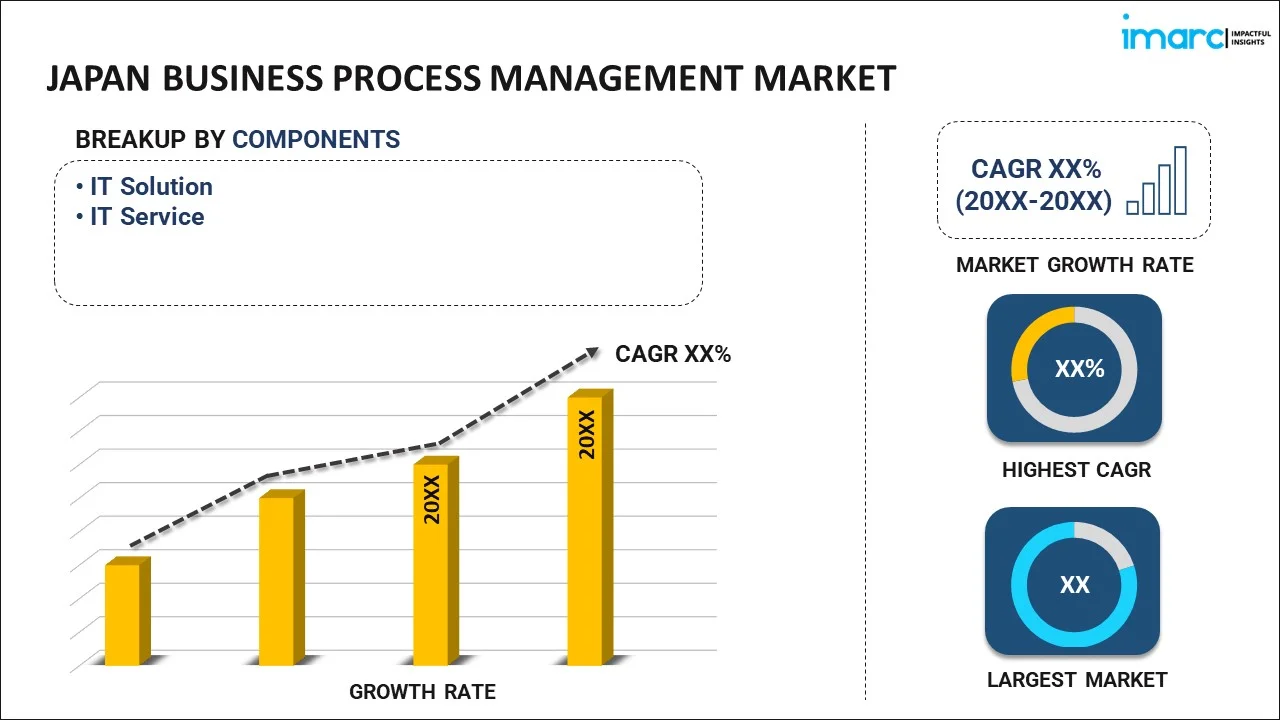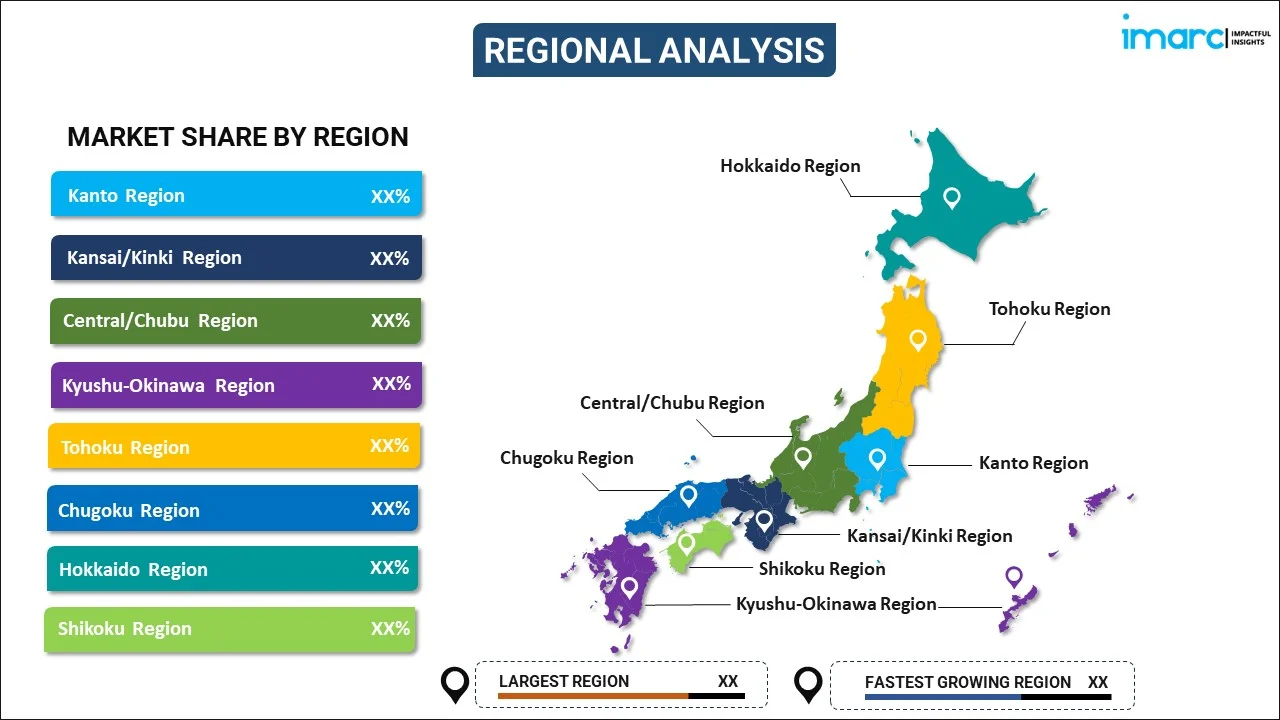
Japan Business Process Management Market Report by Component (IT Solution, IT Service), Deployment Type (On-premises, Cloud), Business Function (Human Resource, Accounting and Finance, Sales and Marketing, Manufacturing, Supply Chain Management, Operation and Support, and Others), Organization Size (SMEs, Large Enterprises), Vertical (Government and Defense, BFSI, IT and Telecom, Healthcare, Retail, Manufacturing, and Others), and Region 2026-2034
Market Overview:
Japan business process management market size reached USD 1,047.6 Million in 2025. Looking forward, IMARC Group expects the market to reach USD 4,688.0 Million by 2034, exhibiting a growth rate (CAGR) of 18.12% during 2026-2034. The increasing globalization of businesses, the rising government initiatives for digital transformation, the growing demand in service industries, and the escalating emphasis on customer-centricity are some of the factors propelling the market.
|
Report Attribute
|
Key Statistics
|
|---|---|
|
Base Year
|
2025 |
|
Forecast Years
|
2026-2034
|
|
Historical Years
|
2020-2025
|
| Market Size in 2025 | USD 1,047.6 Million |
| Market Forecast in 2034 | USD 4,688.0 Million |
| Market Growth Rate (2026-2034) | 18.12% |
Business Process Management (BPM) is a comprehensive approach to optimizing organizational workflows and operations for enhanced efficiency and effectiveness. At its core, BPM involves the systematic design, modeling, execution, monitoring, and refinement of business processes to align with strategic goals and deliver maximum value to stakeholders. This holistic management strategy integrates people, processes, and technology to streamline operations, improve collaboration, and adapt to evolving business environments. BPM often employs process mapping and modeling tools to visualize workflows, allowing organizations to identify bottlenecks, redundancies, or areas for improvement. Automation plays a key role in BPM, enabling the execution of routine tasks with precision, reducing errors, and freeing human resources for more strategic endeavors. Continuous monitoring and analysis of key performance indicators empower organizations to make data-driven decisions, fostering agility and responsiveness. As businesses face increasing complexity and change, BPM emerges as a vital discipline, offering a systematic framework to enhance operational resilience, promote innovation, and drive sustained improvement across diverse industries and sectors.
Japan Business Process Management Market Trends:
The market in Japan is majorly driven by the increasing emphasis on operational excellence and continuous improvement. In line with this, Japanese businesses, known for their dedication to precision and optimization, recognize BPM as a strategic tool to refine workflows, reduce inefficiencies, and enhance overall organizational performance. Furthermore, the rapid technological advancements and embracing of Industry 4.0 principles are pivotal in driving the BPM market. As Japanese enterprises integrate smart technologies, IoT devices, and data analytics into their operations, BPM becomes instrumental in orchestrating these complex, interconnected systems. Besides, the escalating need to manage end-to-end processes efficiently, from manufacturing to customer service, fosters a demand for robust BPM solutions that navigate the intricacies of modern, tech-driven business environments. Furthermore, the rising aging population contributes to the adoption of BPM as a means to address workforce challenges. BPM's automation capabilities provide a solution for businesses grappling with a shrinking labor pool by streamlining routine tasks and optimizing resource utilization. This is particularly relevant in sectors such as healthcare, where BPM can enhance patient care processes amid an aging demographic. Additionally, regulatory compliance and data security concerns bolster the market growth. The nation's commitment to stringent data protection regulations and corporate governance standards incentivizes businesses to invest in BPM solutions that ensure transparency, accountability, and adherence to regulatory frameworks. The resilience-focused approach of Japanese businesses, especially in the aftermath of natural disasters, drives the adoption of BPM as a tool for building organizational agility and continuity planning. BPM's ability to provide visibility into processes, anticipate risks, and facilitate rapid response aligns with Japan's proactive stance toward business resilience, contributing to the sustained growth of the BPM market in the country.
Japan Business Process Management Market Segmentation:
IMARC Group provides an analysis of the key trends in each segment of the market, along with forecasts at the country level for 2026-2034. Our report has categorized the market based on component, deployment type, business function, organization size, and vertical.
Component Insights:

- IT Solution
- Process Improvement
- Automation
- Content and Document Management
- Integration
- Monitoring and Optimization
- IT Service
- System Integration
- Consulting
- Training and Education
The report has provided a detailed breakup and analysis of the market based on the component. This includes IT solution (process improvement, automation, content and document management, integration, and monitoring and optimization) and IT service (system integration, consulting, and training and education).
Deployment Type Insights:
- On-premises
- Cloud
A detailed breakup and analysis of the market based on the deployment type have also been provided in the report. This includes on-premises and cloud.
Business Function Insights:
- Human Resource
- Accounting and Finance
- Sales and Marketing
- Manufacturing
- Supply Chain Management
- Operation and Support
- Others
The report has provided a detailed breakup and analysis of the market based on the business function. This includes human resource, accounting and finance, sales and marketing, manufacturing, supply chain management, operation and support, and others.
Organization Size Insights:
- SMEs
- Large Enterprises
A detailed breakup and analysis of the market based on the organization size have also been provided in the report. This includes SMEs and large enterprises.
Vertical Insights:
- Government and Defense
- BFSI
- IT and Telecom
- Healthcare
- Retail
- Manufacturing
- Others
The report has provided a detailed breakup and analysis of the market based on the vertical. This includes government and defense, BFSI, IT and telecom, healthcare, retail, manufacturing, and others.
Regional Insights:

- Kanto Region
- Kansai/Kinki Region
- Central/ Chubu Region
- Kyushu-Okinawa Region
- Tohoku Region
- Chugoku Region
- Hokkaido Region
- Shikoku Region
The report has also provided a comprehensive analysis of all the major regional markets, which include Kanto Region, Kansai/Kinki Region, Central/ Chubu Region, Kyushu-Okinawa Region, Tohoku Region, Chugoku Region, Hokkaido Region, and Shikoku Region.
Competitive Landscape:
The market research report has also provided a comprehensive analysis of the competitive landscape. Competitive analysis such as market structure, key player positioning, top winning strategies, competitive dashboard, and company evaluation quadrant has been covered in the report. Also, detailed profiles of all major companies have been provided.
Japan Business Process Management Market Report Coverage:
| Report Features | Details |
|---|---|
| Base Year of the Analysis | 2025 |
| Historical Period | 2020-2025 |
| Forecast Period | 2026-2034 |
| Units | Million USD |
| Scope of the Report | Exploration of Historical and Forecast Trends, Industry Catalysts and Challenges, Segment-Wise Historical and Predictive Market Assessment:
|
| Components Covered |
|
| Deployment Types Covered | On-premises, Cloud |
| Business Functions Covered | Human Resource, Accounting and Finance, Sales and Marketing, Manufacturing, Supply Chain Management, Operation and Support, Others |
| Organization Sizes Covered | SMEs, Large Enterprises |
| Verticals Covered | Government and Defense, BFSI, IT and Telecom, Healthcare, Retail, Manufacturing, Others |
| Regions Covered | Kanto Region, Kansai/Kinki Region, Central/ Chubu Region, Kyushu-Okinawa Region, Tohoku Region, Chugoku Region, Hokkaido Region, Shikoku Region |
| Customization Scope | 10% Free Customization |
| Post-Sale Analyst Support | 10-12 Weeks |
| Delivery Format | PDF and Excel through Email (We can also provide the editable version of the report in PPT/Word format on special request) |
Key Benefits for Stakeholders:
- IMARC’s industry report offers a comprehensive quantitative analysis of various market segments, historical and current market trends, market forecasts, and dynamics of the Japan business process management market from 2020-2034.
- The research report provides the latest information on the market drivers, challenges, and opportunities in the Japan business process management market.
- Porter's five forces analysis assist stakeholders in assessing the impact of new entrants, competitive rivalry, supplier power, buyer power, and the threat of substitution. It helps stakeholders to analyze the level of competition within the Japan business process management industry and its attractiveness.
- Competitive landscape allows stakeholders to understand their competitive environment and provides an insight into the current positions of key players in the market.
Key Questions Answered in This Report
The business process management market in Japan was valued at USD 1,047.6 Million in 2025.
The Japan business process management market is projected to exhibit a CAGR of 18.12% during 2026-2034, reaching a value of USD 4,688.0 Million by 2034.
The Japan business process management market is driven by rising digital transformation, demand for workflow automation, and the need to improve operational efficiency. The rising use of cloud-based solutions, the need for regulatory compliance, and a greater emphasis on cost efficiency are driving further growth in the market.
Need more help?
- Speak to our experienced analysts for insights on the current market scenarios.
- Include additional segments and countries to customize the report as per your requirement.
- Gain an unparalleled competitive advantage in your domain by understanding how to utilize the report and positively impacting your operations and revenue.
- For further assistance, please connect with our analysts.
 Request Customization
Request Customization
 Speak to an Analyst
Speak to an Analyst
 Request Brochure
Request Brochure
 Inquire Before Buying
Inquire Before Buying




.webp)




.webp)












